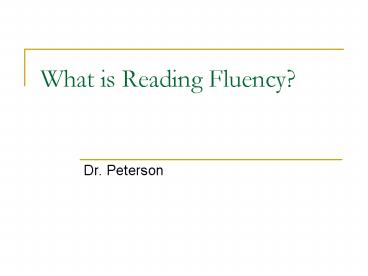What is Reading Fluency - PowerPoint PPT Presentation
1 / 19
Title: What is Reading Fluency
1
What is Reading Fluency?
- Dr. Peterson
2
What is Reading Fluency?
- Involves the ability to read text smoothly and at
a reasonable rate. - Fluent readers read effortlessly
- Speed
- Accuracy
- Proper expression as though they are speaking
- Automatic nature of reading
- Fluent readers are able to focus on ideas in the
text and comprehend the authors message.
3
What Skills Do Fluent Readers Possess?
- Automaticity involves translating letters to
sounds to words effortlessly and accurately. - Quality refers to the readers ability to use
proper intonation or expression (i.e., prosodic
features pitch, juncture, and stress) in ones
voice. - Rate involves attaining appropriate reading
speed according to the readers purpose or the
type of passage.
4
What is an Appropriate Rate?
5
Developing Reading Fluency
- The research-based methods identified to develop
the ability to read fluently are - Direct instruction using guided oral reading
- Guidance from teachers, peers, or parents had
significant and positive impact on word
recognition, fluency, and comprehension across a
range of grade levels (National Reading Panel,
2000). - When students practice a single text repeatedly,
their oral reading becomes fluent.
6
Developing Reading Fluency
- Supporting students using strategies such as
choral reading, buddy or dyad reading, and
computer-assisted reading can be most effective
in a well-conceived reading fluency program. - Use a good deal of modeling.
- Observing, listening to, and imitating fluent
reading models help children learn how to become
fluent readers themselves.
7
Developing Reading Fluency
- Students need massive amounts of practice.
- Independent reading of stories of interest
- Buddy reading
- Guided oral reading
- Research is clear
- Proficient readers spend more time reading
silently than do students having reading problems.
8
Developing Reading Fluency
- Provide students with access to easy reading
materials. - Proficient readers spend more time reading easier
texts than students having reading problems. - Reading easy books may help proficient readers
make a transition from word by word reading to
fluent reading, while poorer readers spend more
time reading materials that are relatively
difficult. - This practice denies students with reading
problems access to reading materials that could
help them develop fluent reading abilities.
9
Organizing for Instruction
- Choose a balanced diet of reading materials for
practice exercises (i.e., stories, nonfiction
materials, poetry) and provide adequate teacher
modeling, student practice with peers, and
independent practice.
10
Organizing for Instruction
Reutzel, D. R., Cooter, R. B. Jr. (2005). The
essentials of teaching children to read What
every teacher needs to know. Upper Saddle River,
NJ Merrill/Prentice Hall.
11
Organizing for Instruction
Reutzel, D. R., Cooter, R. B. Jr. (2005). The
essentials of teaching children to read What
every teacher needs to know. Upper Saddle
River, NJ Merrill/Prentice Hall.
12
Guided Oral Reading Practice
13
Other Research-Based Methods to Build Fluency
- Guided Reading
- Is an essential part of a comprehensive reading
program. - Purposes (a) to develop reading fluency
strategies, (b) to move children toward
independent reading. - Leveled Books
- Books categorized according to their difficulty
so that they can be matched to students at that
level.
14
Other Research-Based Methods to Build Fluency
- Choral Reading
- Unison reading
- Echo reading
- Buddy Reading or partner reading
- Partnered with a more fluent reader or one of
equal fluency
- Book Buddy
- Classroom volunteer tutoring in a one-to-one
setting. - Independent Practice
- Repeated readings
- Sustained Silent Reading (SSR)
- Performance Reading for Fluency
- Readers Theater
15
Other Research-Based Methods to Build Fluency
- Student-Assisted Strategies Neurological Impress
Method (NIM) - Involves the student and a more fluent reader
reading the same text aloud simultaneously. - Both readers read at the same volume in unison at
first, then the models voice gradually fades as
the student becomes more confident. - Thought to impress the fluent reading patterns
of the teacher/student onto the student through
direct modeling.
16
NIM (Neurological Impress Method)
- Each NIM session is aimed at reading as much
material as is possible in 10 minutes. - Reading material for the first few sessions
should be easy and predictable and make sense for
the reader. - The students sit next to each other with the book
facing both of them. The more fluent reader
moves her/his finger beneath the words as they
are spoken in near-unison fashion. - The more fluent readers goal is to keep the pace
when the student starts to slow down. - Pausing for analyzing unknown words is not
permitted. - The more fluent readers voice is directed at the
students ear so that the words are seen, heard,
and said simultaneously. - Usually three sessions per week are sufficient to
obtain noticeable results. This routine should
be followed for a minimum of 10 consecutive
weeks. - This method can be adapted by the teacher through
the use of tape recorded stories (10 minutes).
The individual student can read along with the
tape while following the text independently or
the tape can be used at a listening center. - More fluent readers one-to-one interactions with
individual students results in a better
instructional experience.
17
Reutzel Cooter text page 252.
18
Reutzel Cooter text page 253.
19
- This presentation was prepared with the use of
research and images from - Reutzel, D. R., Cooter, R. B. Jr. (2005).
The essentials of teaching children to read What
every teacher needs to know. - Upper Saddle River, NJ Merrill/Prentice Hall.































